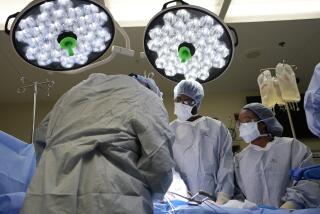Parkinson’s Patient With Brain Graft Termed ‘Visibly Improved’
- Share via
Dickye Baggett, who made history two weeks ago by becoming the first Parkinson’s disease patient to undergo a brain-graft procedure in the United States, is “visibly improved,” her doctors said Wednesday.
Vanderbilt University physicians transplanted cells from the 42-year-old clerical worker’s adrenal glands into her brain in an attempt to reverse the symptoms of her disease. That attempt is beginning to show success, neurosurgeon George S. Allen said.
On Monday, Allen’s team performed the operation on a second patient, a 41-year-old man whose identity has not been disclosed. The patient was awake and talking two hours after the operation, Allen said.
10 More Planned
Allen said his team will perform at least 10 more of the operations “as rapidly as the patients are evaluated and prepared for the surgery.”
Parkinson’s disease affects as many as 1.5 million Americans, most of them over the age of 50. It is caused by the death of brain cells that secrete dopamine, a hormone that is important in transferring information from cell to cell in the brain. Victims develop severe tremors and rigidity of the limbs and frequently also develop dementia, a deterioration of mental functioning.
The adrenal glands, which are above the kidneys, also secrete dopamine, but the hormone is of no value to Parkinson’s victims because it cannot reach the brain.
By transplanting the adrenal cells into the brain, surgeons hope to circumvent this problem. A few scientists, such as Allen, also believe that the cells secrete some other hormone that may actually reverse some of brain damage that results from the disease. Allen’s team is therefore isolating fluid from the brains of their two patients to search for such a hormone.
Physicians in Mexico City who pioneered the technique used at the Nashville, Tenn., university said Wednesday that they have performed the procedure on 12 patients and that they expect to have operated on 20 by August. After the 20th operation, they will stop for an indefinite period to monitor the results of the surgery.
Two members of the team, neurosurgeon Ignacio Navarro Madrazo of Centro Medico La Raza in Mexico City and neurobiologist Rene Drucker-Colin of the University of Mexico, will also travel to New York City next month to participate in the first transplant operation at the New York University Medical Center.
Drucker-Colin said several other U.S. scientists plan to go to Mexico City to learn the procedure before performing it themselves.
Patient Selection
He also noted that the team is changing the criteria for patient selection. “We have decided that it is probably worthwhile to do it in the youngest patients possible because that’s where we have had our greatest successes,” he said. “The older patients have too many other health problems that are related to their age.”
Drucker-Colin also responded to critics, such as John R. Sladek Jr. of the University of Rochester, who argue that the Mexicans have “an unacceptable mortality rate” because two of their 12 patients have died.
One of the patients died 45 days after the surgery from a stroke that occurred “at a site in the brain distant from the transplant site,” Drucker-Colin said. The second died of a heart attack in Los Angeles about 130 days after the transplant.
“We are convinced that both of the deaths were completely unrelated to the transplant operation,” he said.
Drucker-Colin also said their first patient, Joseluis Meza, who received the operation more than a year ago, seems to have reached a plateau: His condition is not improving anymore, but it is not deteriorating either. Meza is raising vegetables in his backyard and selling them from a small store in front of his house.
Their second patient, an engineer from Toluca who was forced to quit working because of his illness, has now returned to his job, Drucker-Colin said.
More to Read
Sign up for Essential California
The most important California stories and recommendations in your inbox every morning.
You may occasionally receive promotional content from the Los Angeles Times.













